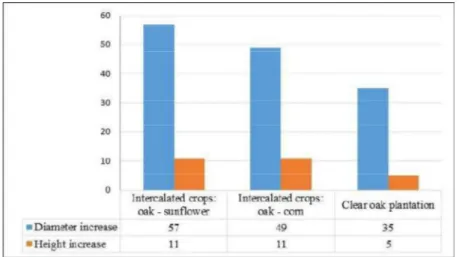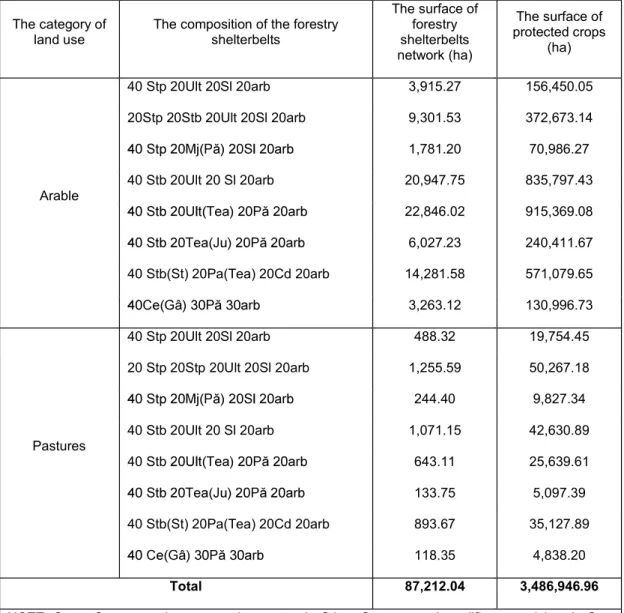AGROFORESTRY SYSTEMS IN ROMANIA
1 1 1, Popovici L1
*Corresponding author: lilianmihaila@yahoo.co.uk
Abstract
Recent interest shown to agroforestry system in Romania is due to the effects of climate change and ecosystem degradation, agroforestry systems ensuring the long-term enhancement of environmental quality and the conservation of natural resources. Forestry shelterbelts for crops protection, pastures with trees, forestry shelterbelts for the protection of the water courses, taungya system are the main agroforestry system realised Romania but still on small areas. On a much smaller scale, other types of agroforestry systems such as: forest farms, harvesting of seeds, flowers, resin from trees, honey by bee-keeping, mushrooms - including truffles are practiced and have been developed through the initiative of farmers particularly smallholders. By presenting the results of the researches and their extension and deepening, it is intended to promote this issue persistently for the implementation of some financing support measures for agroforestry, followed by good practice manuals for their application.
Keywords: agroforestry; ecosystem degradation; support measures; good practice manuals
Introduction
In Romania, the terms of agroforestry systems is a new concept and often used with partial and inconclusive meaning, even if the association of trees and/or shrubs with crops, pasture and animal husbandry has been practiced for a long time and in different ways. The main forms of association of trees, crops and livestock from Romania with ecological, economic and social impact are: forestry shelterbelts for crops protection, forestry shelterbelts for the protection of the main rivers, pastures with trees, taungya system. Other forms of association such as: forest farms and production of non-timber food products in forest (e.g. the harvesting of seeds, flowers, resin from trees, honey by bee-keeping, mushrooms - including truffles) have been developed through the initiative of some farmers and particularly smallholders. They have not yet a regional or national character and no research has been done on them.
Materials and methods
The article is a summary of the concerns related to agroforestry systems in Romania and was based on the consultation of relevant works and on the results of its own researches.
Research on the effect of crops on forest species was carried out comparatively, aiming to highlighting the differences between increases of seedlings from forest plantations maintained in the taungya system and from the clear forest plantation. Biometric characteristics of the seedlings (diameter and height) were determined at the beginning and end of the growing season, for all the seedlings in the experimental surfaces, resulting, by the difference between the two determinations, the annual increment of seedlings.
The network of forestry shelterbelts was placed using GIS-specific techniques. The network was built on the contour of the agricultural landings, at average distances of approximately 600 m between the forestry shelterbelts and 1200 m between the secondary forestry shelterbelts. Basically, a unique forestry shelterbelts width of 10 m has been adopted.
To protect the watercourses, a 1.5 km corridor on both sides of the main waterline was analyzed to signal the presence of forests. In addition to the GIS method used a stratification of the soil information has been made, separating the soils from the waterside (haplic fluvisols, dystric fluvisols, eutric cambisols). From the area occupied by alluvial soils, the land areas without forest vegetation and those with forest vegetation were divided.
Results and discussion The so- taungya system
the first stage of forestry plantation, has been practiced and is still practiced, in a smaller scale, in the Euramerican poplar plantations and acacia plantations installed the south of the country, plantations are made at large schemes (from 4 x 4 m to 7 x 7 m) and respectively medium: 2 x 1 m. The main purpose of setting up this agroforestry system is carrying out maintenance work during the establishment stage of forest plantations, improving soil properties and finally to diversify production. The immediate effect of maintenance work on young forest plantation in the agroforestry system is also seen in the increase in diameter and height of the young trees (Figure 1). It also the canopy of the trees closes faster and in the long run the productivity of the stands increase.
Figure 1: The growth of diameters and heights (%) for oak seedlings in "taungya system" vs - period: spring autumn.
The forestry shelterbelts for crops protection are one of the most popular types of agroforestry system in Romania. Their achievement is done by both owners and administrators of agricultural land, pastures, farms, either individuals or companies.
The areas most affected by climate change are those in the south of the country (The Romanian Plain and Dobrogea), but agricultural areas in the western and eastern parts of the country require also protection as a result of imbalances in climate characteristics. Therefore, the forestry shelterbelts are mainly designed to mitigate climatic extremes (the analyzed areas being characterized by average annual temperatures of about 110C, average annual precipitation below 500 mm and de Martonne aridity index between 20 and 23), to improve the conditions for the growth of crops, to increase fertility and soil conservation.
For the southern area of the country, the network of forest protection belts would cover about 87,200 ha, which will protect about 3,500,000 ha of agricultural fields (crops and pastures) resulting in an approximate percentage of occupancy of agricultural land with forest vegetation of 2-3% (Table 1) et al. 2010). It had been proposed 8 afforestation formulas, depending on the site conditions in the respective areas.
Table 1: The surface and composition of the proposed forestry shelterbelts for crops protection from The Romanian Plain and Dobrogea.
The category of land use
The composition of the forestry shelterbelts The surface of forestry shelterbelts network (ha) The surface of protected crops (ha) Arable 40 Stp 20Ult 20Sl 20arb 3,915.27 156,450.05 20Stp 20Stb 20Ult 20Sl 20arb 9,301.53 372,673.14 1,781.20 70,986.27 40 Stb 20Ult 20 Sl 20arb 20,947.75 835,797.43 22,846.02 915,369.08 6,027.23 240,411.67 40 Stb(St) 20Pa(Tea) 20Cd 20arb 14,281.58 571,079.65 3,263.12 130,996.73 Pastures 40 Stp 20Ult 20Sl 20arb 488.32 19,754.45 20 Stp 20Stp 20Ult 20Sl 20arb 1,255.59 50,267.18 244.40 9,827.34 40 Stb 20Ult 20 Sl 20arb 1,071.15 42,630.89 40 Stb 643.11 25,639.61 133.75 5,097.39 40 Stb(St) 20Pa(Tea) 20Cd 20arb 893.67 35,127.89 118.35 4,838.20 Total 87,212.04 3,486,946.96
NOTE: Stp = Quercus pubescens, pubescent oak; Stb = Quercus pedunculiflora, greyish oak; St =
Quercus robur, oak; Ce = Quercus cerris Quercus frainetto, Hungarian oak; Ult =
Ulmus pumila, Siberian elm; Mj = Fraxinus ornus Pyrus pyraster, wild pear; Tea
= Tilia tomentosa, silver lime; Sl = Eleagnus angustifolia, oleaster; Pa = Acer platanoides, Norway maple; Cd = Prunus cerasifera, cherry plum; Arb= shrubs
In the context of efforts to reduce greenhouse gas content, the forestry plantation to be installed within this agroforestry system will store an appreciable amount of carbon (Blujdea et al. 2012). Research and recommendations on the establishment of forest belts for protection of the water courses (Siret, Ialomita, Arges, Olt, Jiu, Mures) have been made since the 50s of the last century (Lonescu et al. 1960). These are included in the general issue of forestry shelterbelts. The analysis of the main watercourses showed that the area occupied with forest vegetation in a corridor of 1,5 km width of one side and another is relatively small (ranging from 10,21% for the Siret River to 26,77 % in the case of the Jiu River) (Mihaila et al. 2010). It is believed that this corridor allows for the placement of either a single forest protection belt of a larger width, or many forest belts separated from agricultural areas. The small percentage of forest vegetation was due to its systematic removal and use of land for the extension of agricultural land or, more recently, for the development of living areas close to river.
The lack of forest vegetation have a great ecological impact, increasing the share of agricultural land more or less degraded near the watercourse. The goal of achieving forestry shelterbelts for water protection is precisely to protect both agricultural land and watercourses. For instance, the areas where forest belts for water protection are required vary from 124,054 ha (19.39%) for the Mures River, to 3,702 ha (0.58%) for the Tisa River (Figure 2). Generally the downstream of the watercourses represent a protected area, being sites included in the Natura 2000.
Figure 2: Areas to be afforested on a 1.5 km corridor both sides of main rivers from Romania. The first stage in the realization of forest belts for water protection consists in the particular analysis of each water course in terms of climatic and site conditions, the presence or absence of forest vegetation and the main functions of these forest protective belts (bank stabilization, filtering pollutants from agriculture or industry etc.).
Pastures with trees, the most representative type of silvopastoral systems have a long tradition in our country as in many other countries. During the period between the 50s and 80s of the last century, they developed in an organized manner, and the silvopastoral development activity
The trees in silvopastoral systems are from rustic forest species, resistant to climatic, edaphic, anthropic adversities, capable of exploiting the productive potential of the soil, such as: oak, walnut, cherry, wild pear etc.
Regarding the second component of silvopastoral systems, animals, the most frequent are cattle and sheep, but also horses, goats, pigs can be found.
The type of pasture (grassland), the third component of silvopastoral systems, is an important element within them, its quality and productivity being directly related to livestock production. The choice of high nutritional fodder species (Festuca sp., Agrostis sp., Carex sp., Poa sp., Bromus sp., etc.) as well as technological measures have the role in improving the permanent pasture by increasing the production, its quality and eventually the evolution of the blanket works: (i) land improvement works which include anti-erosion protection works on soils with slopes over 300; (ii) regeneration of the blanket herbaceous by fertilization and over-sowing; (iii) total regeneration of land by sowing.
The knowledge of the characteristics of grass and fodder growth, grazing time, grazing capacity and optimal numbers of animals avoid the degradation of pasture by impoverishment and deterioration of fodder species and seedlings harm. All these are more or less theoretical elements that can be the basis for the large-scale development of pastures with trees many of them currently degraded
Conclusion
Although there are measures to support agroforestry systems at EU level, in the agricultural and forestry policy of Romania have not yet been taken steps to promote support measures for the development of agroforestry systems. There are some vague references to agroforestry in the national development strategy for agriculture, but no further steps have been taken to promote measures to finance these agroforestry systems or to elaborate good practice manuals for their application.
The research (unfortunately discontinuous) carried out over the past two decades on the development of agroforestry systems and the initiatives of some farmers and especially smallholders advocates the promotion of agroforestry systems. In addition, support actions are needed to persuade landowners that agroforestry systems contain a complex land use, both from agriculture and forestry point of view and they are not supposed to replace stable, specialized and productive systems, but to improve those that are under degradation, unstable and located in areas affected by drought, aridity.
References
Blujdea VNB, Pilli R, Dutca I, Ciuvat L, Abrudan IV (2012) Allometric biomass equations for young broadleaved trees in plantations in Romania. Forest Ecol and Manag 264: 172-184.
with summary in english), Bucharest.
Lonescu A, Marcu Gh, Moisuc Gh, Lupe I (1960) Research on the need for state shelter belts on water courses. In: P.R. of Romania. In: Studies and Research, vol. XXI. Agro-Forest Publishing House (in romanian with summary in french and russian), pp. 101-133.
lishing House (in romanian with summary in english), Bucharest.
romanian with summary in english), Bucharest.
The Forest Engineer's Manual. Technical Publishing House Bucharest (in romanian) 81: 292 306.


